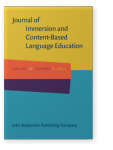Vol. 10:1 (2022) ► pp.33–61
Vol. 10:1 (2022) ► pp.33–61
Learning a foreign language in immersion and second language acquisition contexts – students’ multilingual experiences with French in Ireland
This article looks at how bilingual students harness previous language experience when learning a new language. Research generally affirms that higher second language proficiency is linked to higher levels of proficiency in subsequent language learning and greater use of previously acquired language skills. In the Irish context, however, the varied nature of acquiring/learning languages and perceptions of linguistic distance potentially hinder students in mobilizing their experience with English and Irish when learning foreign languages at school. The study presented here examines how bilingual language experience can be harnessed through analysis of quantitative and qualitative data from English-medium and Irish-medium secondary school students in Ireland, focusing on how they identify and deploy elements of this experience when learning French via the elaboration of strategies and use of metalinguistic awareness. Beyond measures of proficiency, findings show the need for pedagogical tools that allow students to fully exploit their previous language experience.
Article outline
- 1.Introduction
- 2.Languages and language learning in Ireland
- 2.1Languages in society
- 2.2Languages in education
- 3.From bilingualism to foreign language learning
- 3.1General research trends
- 3.2Bilingualism and foreign language learning in the Irish context
- 4.Study design and implementation
- 4.1Rationale
- 4.2Research context and participants
- 4.3Instruments and procedures
- 5.Findings
- 5.1General perceptions of the utility of previous language experience
- 5.2Harnessing previous language experience – English-medium schools
- 5.3Harnessing previous language experience – Irish-medium schools
- 6.Discussion and conclusion
- Notes
-
References
